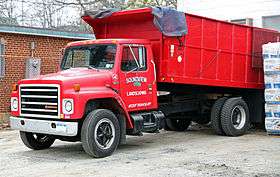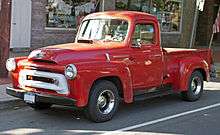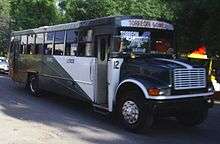International S series
The International S series is a range of trucks that was manufactured by International Harvester (later Navistar International) from 1977 to 2001. Introduced to consolidate the medium-duty IHC Loadstar and heavy-duty IHC Fleetstar into a single product range, the S series was slotted below the Transtar and Paystar Class 8 conventionals.
| International S series | |
|---|---|
 1989 Navistar International S-1700 dual-axle dump truck | |
| Overview | |
| Manufacturer |
|
| Also called | Navistar International 4000 series Navistar International 8000 series |
| Production |
|
| Body and chassis | |
| Class | Class 6-7 medium-duty truck |
| Body style |
|
| Layout | 4x2 6x4 |
| Related | International S series "Schoolmaster"/International 3800 |
| Powertrain | |
| Engine | Gasoline 197–236 hp (147–176 kW) Diesel 150–500 hp (110–370 kW) |
| Transmission | Manual Automatic |
| Chronology | |
| Predecessor | |
| Successor | |
The IHC S series was produced in a number of variants for a wide variety of applications, including straight trucks, semitractors, vocational trucks, and severe-service trucks. Additionally, the S series was produced in other body configurations, including a four-door crew cab, cutaway cab, cowled chassis, and a stripped chassis (primarily for school buses). The chassis was produced with both gasoline and diesel powertrains (the latter exclusively after 1986), single or tandem rear axles, and two, four, or, six-wheel drive layouts.
The last complete product line designed within the existence of International Harvester, the S series was produced in its original form through 1989. To reflect the change to Navistar, a major facelift updated the exterior and interior of many models, which were produced through 2001. As a replacement for the S series, Navistar introduced the 4000 series and 7000 series (known as the International DuraStar and International WorkStar since 2008).
Previous use of name

The S-series model designation was first used by International Harvester during the 1950s; for 1955, the S-series served as the replacement for the R-series range of trucks, including light and medium-duty trucks, along with the Travelall utility vehicle.
The S-series ranged from the S-110 pickup truck to the S-184 truck (with a 24,000 pound GVWR); the latter received a 308 cubic-inch "Black Diamond" gasoline engine.[1]
During the 1957 model year, the A-series.replaced the S-series light and medium trucks[2]; for heavy-duty trucks, the R-Series remained (until 1972). The front sheetmetal of the S-series was adopted by the International Metro (used by its hooded Metroette variant) through 1962.[3] The S-184 continued production in Brazil until 1966 (when Chrysler purchased the Brazilian subsidiary of International Harvester).[4]
First generation (S series; 1978–1989)
In April 1977, International Harvester unveiled the medium-duty S series at an event at the New Orleans Superdome.[5] The initial lineup consisted of heavier-duty 2200, 2500, and 2600 models (28,000-45,000 lb GVW[lower-alpha 1]), replacing the Fleetstar. In the summer of 1978,[6] lighter-GVWR models (replacing the Loadstar) were released for sale. The 21 models of the full lineup had a high degree of parts interghangability, this standardisation helped lower the number of parts used by thirty percent.[7]
Following the discontinuation of the IHC pickup-truck line in 1975, the S series was designed with a model-specific cab, replacing the pickup-truck cab used for the Loadstar (designed for the 1957 A series). More vertically-oriented than its predecessor, the design was much wider as well. To lower maintenance costs, all windows in the cab were designed with flat glass, including the windshield. Similar in style to the tilting hood introduced for the Loadstar in 1972, all S-series trucks were given a tilting fiberglass hood.
The S series would be produced throughout the 1980s largely unmodified. 1987 would mark several changes to the S-series trucks. To reflect the corporate change of the company from International Harvester to Navistar International, S-series trucks saw changes in their badging (alongside all International vehicles). On the grille, the word "International" across the top of the grille was replaced by a red Navistar "diamond" logo alongside "International" in red at the bottom left of the grille. Inside, the IHC "tractor" logo on the steering wheel was replaced by a Navistar diamond logo. In a major shift, for 1987, International became the first truck manufacturer to produce a medium-duty product line powered exclusively by diesel engines.
Models
Originally intended to use the International Tristar nameplate, the S series consolidated the aging Loadstar and Fleetstar trucks under a single product line. Tandem-axle (6x4) versions of the S series were named F-series trucks.[8]
Class 6 trucks
The S1600, S1700, S1800, and S1900 were introduced in 1979. Replacing the International Harvester Loadstar model line, the model was produced in a number of configurations, with single and tandem rear axles, 4x4/6x6 drive options, and gasoline and diesel engines. The S-1800 and S-1900-were produced as both semitractors and straight trucks, while the S-1700 and S-1800 were used in the production of International Harvester bus chassis (primarily for school bus use).
Class 7-8 trucks
Introduced in 1978 as the replacement for the Fleetstar, the S2100 and S2200 were joined by the severe-service S2500 and S2600, slotted below the International Paystar 5000. Configured primarily as tractors, the S2100 was fitted with a sloped hood. To accommodate larger-bore diesel engines under a standard-length hood, the S2200 was fitted with a widened cab (distinguished by a two-piece windshield).
In 1982, the S2300 was introduced; the model line was essentially an S2100 with International diesel engines replaced with Cummins-sourced powertrains.[9]
1978–1983 models
| Model[10] | Max. front GAWR[lower-alpha 2] | Max. rear GAWR | Engine[lower-alpha 3] | Trans [lower-alpha 4] |
|---|---|---|---|---|
| 1600 4x2 | 5,000 lb (2,300 kg) | 15,000 lb (6,800 kg) | V-345 | 4M, 4A |
| Binder 4x2 | 1,600 lb (730 kg) | 15,000 lb (6,800 kg) | V-345 | 5M, 4A |
| 1700 4x2 | 7,500 lb (3,400 kg) | 15,500 lb (7,000 kg) | MV-404, D-170 | 10M, 5A |
| 1800 4x2 | 6,000 lb (2,700 kg) | 15,500 lb (7,000 kg) | MV-446, DT-466 | 13M, 5A |
| 1800 4x4 | 9,000 lb (4,100 kg) | 15,500 lb (7,000 kg) | MV-446, DT-466 | 5M, 4A |
| 1900 4x2 | 8,000 lb (3,600 kg) | 17,500 lb (7,900 kg) | MV-446, DT-466 | 10M, 5A |
| 1900 6x4 | 9,000 lb (4,100 kg) | 34,000 lb (15,000 kg) | MV-466, DT-466 | 10M, 5A |
| 1900 6x6 | 9,000 lb (4,100 kg) | 34,000 lb (15,000 kg) | MV-466, DT-466 | 5M |
| 2100 4x2 | 9,000 lb (4,100 kg) | 17,500 lb (7,900 kg) | V-537, DT-466 | 10M |
| 2100 6x4 | 9,000 lb (4,100 kg) | 34,000 lb (15,000 kg) | V-537, DT-466 | 10M |
| 2200 4x2 | 10,800 lb (4,900 kg) | 23,000 lb (10,000 kg) | Cat 3406 | 13M |
| 2200 6X4 | 12,000 lb (5,400 kg) | 23,000 lb (10,000 kg) | Cat 3406 | 13M |
| 2300 4x4 | 12,000 lb (5,400 kg) | 41,000 lb (19,000 kg) | ||
| 2500 4x2 | 16,000 lb (7,300 kg) | 29,000 lb (13,000 kg) | Cat 3406 | 13M |
| 2500 6X4 | 18,000 lb (8,200 kg) | 44,000 lb (20,000 kg) | Cat 3406 | 13M |
| 2600 4x2 | 16,000 lb (7,300 kg) | 29,000 lb (13,000 kg) | Cum PT | 13M |
| 2600 6X4 | 18,000 lb (8,200 kg) | 44,000 lb (20,000 kg) | Cum PT | 13M |
Second generation (1989–2001)
During 1989 production, the S-series line underwent a major upgrade. Although the cab itself was retained, interiors saw complete redesigns, with all-new dashboards and interior controls; a two-spoke steering wheel with the spokes in the inverted "V" configuration replaced the previous three-spoke wheel with spokes in the classic "Y" configuration in use. In the interest of aerodynamics, many models saw redesigned hoodlines, with halogen headlamps and wraparound turn signals.
During its production life, the second-generation vehicles saw few major changes, with the exterior remaining nearly unchanged throughout its entire production. In contrast, the interior would see several updates. In 1992, the instrument panel was redesigned, with the rest of the interior redesigned in 1995.
Models

As part of the redesign, Navistar split its medium-duty S-series range into three separate model lines. The 4000 series served as the replacement for the S1600 through 1900 Class 5-7 trucks (with bus chassis rechristened the 3000 series), while the 8000 series replaced the S2100 and S2300 (the wide-body S2200 was discontinued). Again slotted below the Paystar, the 2500 and 2600 severe-service trucks dropped their S-series prefix.
Class 5-7 trucks
Replacing the S1600 through S1900, the 4000 series was again produced in a number of configurations, with single and tandem rear axles, 4x4/6x6 drive options. Produced exclusively with diesel engines, the 4000 series was produced with the IDI V8 and DT360/DT466 engines.
The 4000 series was produced through 2001, when it was replaced by an all-new 4000 series (now the International DuraStar).
Class 7-8 trucks
Replacing the S2100 and S2300, the 7100 and 8100 were introduced in 1989; the wide-body S2200 was not replaced. Configured nearly exclusively as tractors, the 8000 series was powered by the Cummins L10 diesel; the 7100 was a variant powered by the DT466.
The 8000 series was produced through 2001, when it was replaced by an all-new 8000 series (now the International Transtar).
Severe-service trucks
Again slotted below the Paystar, the 2500 and 2600 severe-service trucks dropped their S-series prefix. During the 1990s, the set-back axle 2674 was restyled with the aerodynamic hood of the 8300. The 2500/2600 remained in production through 2003, outlasted only by the 3800 school-bus chassis.
| Model | Replaced | Notes |
|---|---|---|
| 4500 | S1600 | Low-profile chassis |
| 4600 | ||
| 4700 | Low-profile chassis | |
| 4900 | S1800 | Available with tandem rear axles. |
| 8100 | S1900 | |
| 8200 | Long hood semi-tractor | |
| 8300 | Long hood semi-tractor | |
| 2500 | Long hood | |
| 2600 | Long hood, set-back front axle Available in 4x2, 4x4, 6x4, and 6x6 drive | |
| 3600 | Australasia-specific model, similar to 2500 model-specific hood |
Bus use


Throughout its production, the S series would be used as a cowled chassis for bus manufacturers. While used primarily for yellow school buses in the United States and Canada, the S series also was used outside of North America as a basis to produce other types of bus bodies. Introduced in 1979, the bus variant of the S series would be one of the final models designed by International Harvester before its transition to Navistar. In 1989, the S-series bus chassis was rechristened the 3000 series with the fitment of the new-generation Navistar cowl.
Produced until 2004, the bus chassis would outlive its truck counterpart by three years; its 25-year production run is the longest of any product ever sold by International Harvester or Navistar.
Models
| Models | Replaced | Notes |
|---|---|---|
| S-1700
S-1800 |
Loadstar 1703
Loadstar 1803 |
|
| 3600 | See Thomas Vista
Produced 1992-1998 | |
| 3700
3800 |
S1700
S1800 |
Powertrain
| Model[lower-alpha 5] | Displacement | Type[lower-alpha 6] | Power | Torque |
|---|---|---|---|---|
| V-345 | 345 cu in (5.7 l) | G V8 | 197 hp (147 kW) | 309 lb⋅ft (419 N⋅m) |
| V-392 | 392 cu in (6.4 l) | G V8 | 236 hp (176 kW) | |
| MV-404 | 404 cu in (6.6 l) | G V8 | 210 hp (160 kW) | 336 lb⋅ft (456 N⋅m) |
| MV-446 | 446 cu in (7.3 l) | G V8 | 235 hp (175 kW) | |
| D-190 | 549 cu in (9.0 l) | D V8 | 190 hp (140 kW) | 340 lb⋅ft (460 N⋅m) |
| IDI-420 | 420 cu in (6.9 l) | D V8 | 170 hp (130 kW) | |
| IDI-444 | 444 cu in (7.3 l) | D V8 | 190 hp (140 kW) | 388 lb⋅ft (526 N⋅m) |
| Cat 3208 | 636 cu in (10.4 l) | D V8 | 210 hp (160 kW) | |
| Cat 3406 | 893 cu in (14.6 l) | D I6 | 380 hp (280 kW) | |
| Cum NTC-350 | 855 cu in (14.0 l) | D I6 | 350 hp (260 kW) | |
| Cum M11 | 659 cu in (10.8 l) | D I6 | 500 hp (370 kW) | 1,550 lb⋅ft (2,100 N⋅m) |
| DD 6-71 | 426 cu in (7.0 l) | D I6 | 230 hp (170 kW) | |
| DD 6V-92 | 552 cu in (9.0 l) | D V6 | 335 hp (250 kW) | |
| DD 8V-92 | 736 cu in (12.1 l) | D V8 | 400 hp (300 kW) |
See also
| Wikimedia Commons has media related to |
Notes
- Gross Vehicle Weight Rating is the loaded weight of the truck.
- Gross Axle Weight Rating is the loaded weight of the axle.
- Highest rated gasoline, diesel engine.
- Speeds in manual(M), automatic(A) transmission
- Engines are International unless noted as Caterpillar(Cat), Cummins(Cum), or Detroit Diesel(DD).
- Gasoline(G), diesel(D), inline(I), (V), and number of cylinders.
References
- Crismon, Frederick W. (2002), International Trucks (2 ed.), Minneapolis, MN: Victory WW2 Publishing, p. 272, ISBN 0-9700567-2-9
- "International Harvester History: Trucks". International Harvester. 1961.
- Crismon, p. 336
- Shapiro, Helen (Winter 1991). "Determinants of Firm Entry into the Brazilian Automobile Manufacturing Industry, 1956-1968". The Business History Review. 65 (4): 879. doi:10.2307/3117267. JSTOR 3117267.
- Crismon, p. 485
- Crismon, p. 492
- Wren, James A.; Wren, Genevieve (1979). Motor Trucks of America. Ann Arbor MI: The University of Michigan Press. p. 320. ISBN 0-472-06313-8.
- Crismon, p. 495
- "Question about International S-series trucks". hankstruckforum.com. Archived from the original on July 18, 2008. Retrieved 2017-05-07.
- "International Truck Specifications – S Line – 1956–1983". Wisconsin Historical Society. 2013. Retrieved 2014-10-28.
- American Truck & Bus Spotter's Guide: 1920-1985, by Tad Burness.
- International Trucks, by Frederick W. Crismon